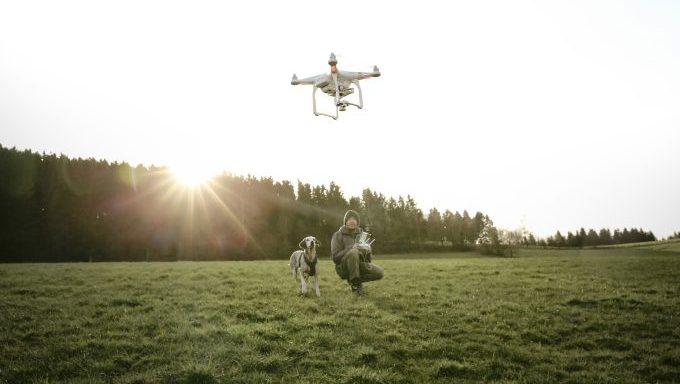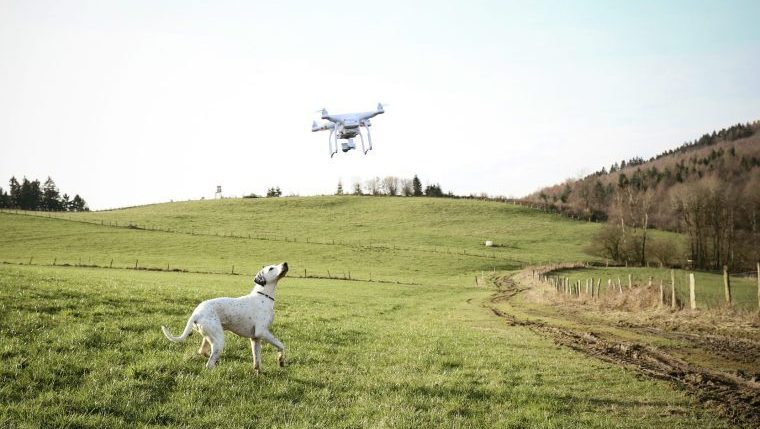
Increasingly, dogs that roam are found by drones — and they are helping to rescue dogs worldwide. In the UK alone, drone pilots have helped search for, and rescue, thousands of missing canines.
One organization, Drone SAR for Lost Dogs UK, has brought home over 2,750 missing dogs with the help of approximately 3,000 volunteer drone pilots and 2,500 volunteer ground searchers across the UK and Ireland. The founder, Graham Burton, will receive the International Fund for Animal Welfare Award. Burton told BBC Radio Wales Breakfast, “It’s amazing when you’ve reunited an owner with its dog.”
Local hero Erica Hart of South Yorkshire, England, is a search and rescue team all on her own. Using a thermal imaging drone, she locates lost pups in South Yorkshire, England, and reunites them with their families. The BBC news reported that Hart has been using the technology for the past six years — and has already helped reunite 200 dogs with their parents. In this video by the BBC Hart says the feeling of finding a lost dog is “like winning the lottery…it’s absolutely priceless.”
The Notorious Sausage Drone
After police, firefighters and coastguards failed to rescue Millie the Jack Russell-Whippet cross from treacherous mudflats and rising tide, one clever rescuer attached a sausage to a drone and Millie followed the dangling banger to higher ground. After checking Civil Aviation Authority regulations and the MTOW (Maximum Take-Off Weight) of their machines, the rescuers calculated they could attach a single sausage to a drone, and a resident just happened to have sausages on the beach where the Denmead Drone Search and Rescue team was flying their machines. What are the odds? Millie is one lucky pup. (Check out this video of the rescue.)
Unsung Heroes
In September 2021, a volcano that erupted on the island of La Palma in the Canary Islands forced thousands of residents to evacuate, but some dogs were trapped by lava flows for almost a month until a mysterious gang calling themselves the “A Team” rescued the canines before a planned — and legal — drone mission. (The “A Team” remains anonymous because their rescue was illegal. Under Spanish law, drones are normally not allowed to transport people or animals.)
According to the Guardian, a local animal association arranged for two drone firms to drop off food and water for the emaciated animals. A crew from the industrial drone operator Aerocameras planned to send a 110-pound drone equipped with a wide net to trap the dogs one by one and fly them to safety.
“We don’t have experience transporting a live animal by drone. Nor does anyone,” the company’s CEO, Jaime Pereira, told private television Telecinco. No one knew how the dogs would react to the drone, particularly if it wasn’t dangling a sausage. “The dog could react by running away, moving, jumping…The success of the mission will depend largely on how the dogs respond to the drone,” Pereira added.
In the A-Team’s video, a photo with a banner in Spanish reads, “Stay strong La Palma, the dogs are alright.” The banner is signed “The A-Team,” aka Unsung Heroes. Days after it announced the rescue last month, the A-Team released another video to show that the dogs were alright and that they were being cared for and fed. The anonymous group then gave the dogs’ location to veterinarians, reported the Spanish agency for animal rights, which said the canines were “in perfect health.”
“We have no idea how they carried out the rescue,” Sergio García, head of the animal rights agency, said.
Drones Over America
In the U.S., drone pilot and animal rescuer Douglas Thron works with the animal rescue and disaster relief organization Compassion Kind. He is also a cinematographer. Thron pilots high-end drones equipped with infrared and zoom cameras as well as powerful spotlights to find animals who are missing, abandoned, or injured after natural disasters, such as the 2021 Kentucky tornado. More recently, he rescued lost pets in Ukraine. You can check out his new docuseries, Doug to the Rescue, available on CuriosityStream.
“A dog is such a loving animal,” Thron said. “Despite all the trauma they’ve been through, in a matter of minutes… their tail’s wagging, they’re licking you and they’re just the most forgiving, loving creatures on earth. If you give it love it’s going to give you love back.”
One of Thron’s Instagram posts shows “ how the infrared and 180x zoom lens works on my drone to find animals in bombed-out buildings of Ukraine. The animals are first found via their body heat with the infrared camera. From there I switch to the zoom lens and verify if it’s an animal and if so what kind of animal and does it need rescuing. If it needs help then we immediately hand catch the animal if possible and if not we set up a live trap and catch it.”
Ryan Okrant is co-founder and executive director of Animal Survival & Safety Emergency Response Team (ASSERT), a drone animal-rescue organization, thanks to collaborating with Thron. On his website, Okrant says that Thron was using a drone for a movie that they were filming. He had the idea of trying to find a way to get the infrared scope onto the drone. They met in Kentucky and their combined efforts led to 41 animals being rescued. Unfortunately, the pair are not allowed to use drones in Ukraine but Okrant says they are currently working on a “drone project with the Dominican Republic’s government to return there and help locate dogs stranded out in their rubbish fields and such.”
Drones Are a Dog’s Best Friend
Drones are included in Petsearchers Canada‘s arsenal of rescue equipment, along with Bloodhounds, infrared imaging, live traps, and cameras. Its “Missing Pets in BC” page has over 34,000 followers and volunteers have helped to bring over 20,000 pets back home to their families since 2012.
Petsearchers says their drone can zone in on your pet and automatically follows up to 5 kilometers away: “We have constant live streaming of the search and can video record and take pictures as well. An aerial search can be an extraordinarily effective tool when we have a pet roaming at large in a rural or mountainous setting where there is just too much ground to cover to be able to track your pet on foot in a timely fashion.”
Drones all over the world are helping to find lost animals — but they have been known to cause fear, stress, anxiety, and aggression in dogs. Erica Hart suggests putting a GPS dog tracker on your canine’s collar so you can track them wherever they roam — no drone required — for your peace of mind and your animal’s safety.









